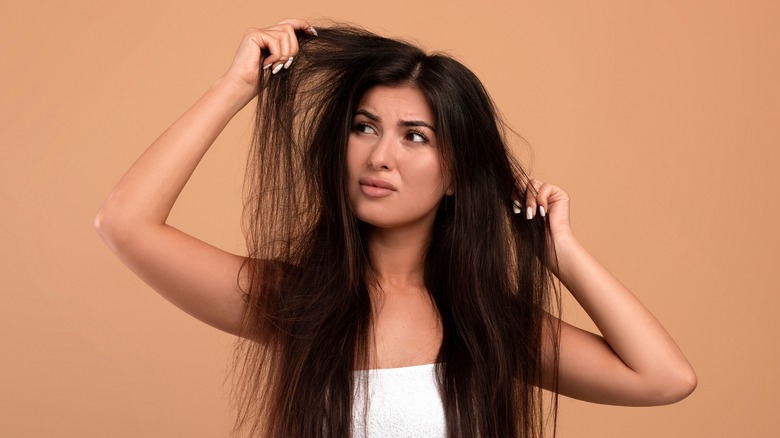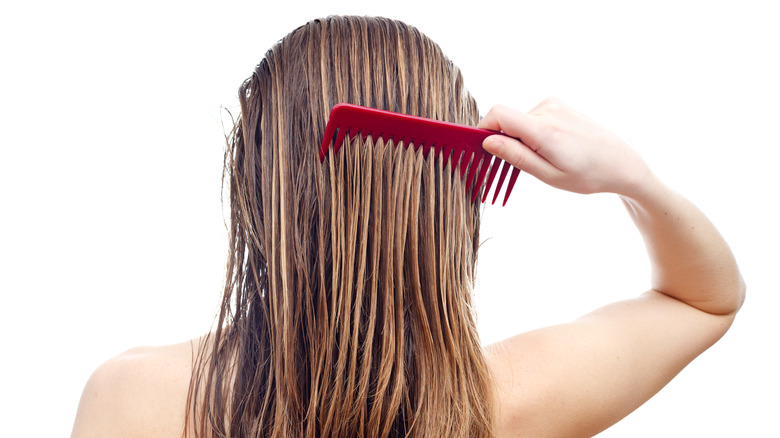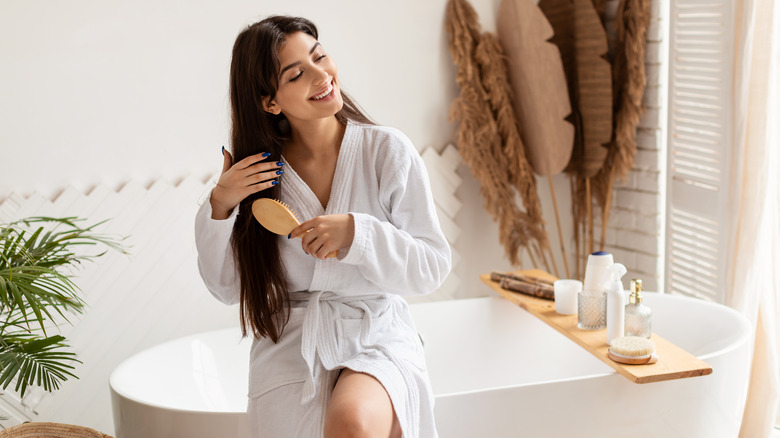The Anti-Frizz Ingredient That's Probably In Your Leave-In Conditioner
Whether you're strolling around perusing products in your local supermarket or you're seated at home turning a bottle of leave-in conditioner over in your hand to get a better look at the list of ingredients, the desire to know more about what you're putting into and onto your body is growing. In fact, according to a 2015 survey, 59% of female shoppers read the labels on cosmetic products extensively before purchase, per Cosmetic Design.
Leave-in conditioners, unlike traditional conditioners, are lightweight haircare products that are applied to your locks after you've washed and towel-dried them, as Healthline clarified. What a leave-in conditioner actually does includes providing moisture and allowing for easier and more effective styling.
Although all types of hair can benefit from leave-in conditioners, you may have seen your friends or family members who have dry, damaged, or frizzy hair seeking out this product with more fervor. This is likely because of one crucial ingredient that's in leave-in conditioners which helps keep hair tame and healthy.
Behentrimonium chloride is found in hair conditioning products
Behentrimonium chloride might be a mouthful to pronounce but the purpose of it is pretty straightforward, according to haircare experts. Shari Sperling, DO, a board-certified dermatologist and the founder of Sperling Dermatology, informed Byrdie that this pertinent ingredient "is part of the mustard plant family and commonly known as rapeseed or canola." It has anti-static and shine-promoting properties.
Behentrimonium chloride is waxy in texture and has a fishy smell, according to Special Chem. It also acts as a hair conditioning and emulsifying instrument. Furthermore, this anti-frizz ingredient is also a "quaternary ammonium salt" that acts as a preservative primarily due to its antibacterial nature, as You Probably Need a Haircut points out.
You may have noticed that after using a leave-in conditioner that contains behentrimonium chloride, your tresses are generally easier to detangle and style. Board-certified dermatologist and podcaster Anna Guanche, MD, explained to Byrdie: "The positive electrical charge within the compound contributes to the super conditioning and allows hair to be more manageable and soft."
How much behentrimonium chloride is safe to use?
While there are no restrictions on what kind of hair can benefit from this particular ingredient, dermatologist and podcaster Anna Guanche told Byrdie that the emulsifying agent is especially "beneficial for people with textured, curly, or thick hair because of the detangling properties and frizz control." Anybody who's struggled with keeping their beautiful yet voluminous hair somewhat tame for an important occasion can relate.
In fact, you can find behentrimonium chloride in other haircare products too, including certain shampoos, serums, and even beard cleansers, per Special Chem. The ingredient also helps colored or heat-damaged hair, especially those tresses that have been chemically treated with bleach, for instance, as The Derm Review notes.
The concentration of the ingredient is what's going to determine how safe it is for use (via You Probably Need a Haircut). While there are plenty of leave-in conditioners for everyday use, Guanche cautions against using haircare products with "more than 0.1 percent, because then it can be harmful to the skin, scalp, and hair follicle," as she warned Byrdie.


